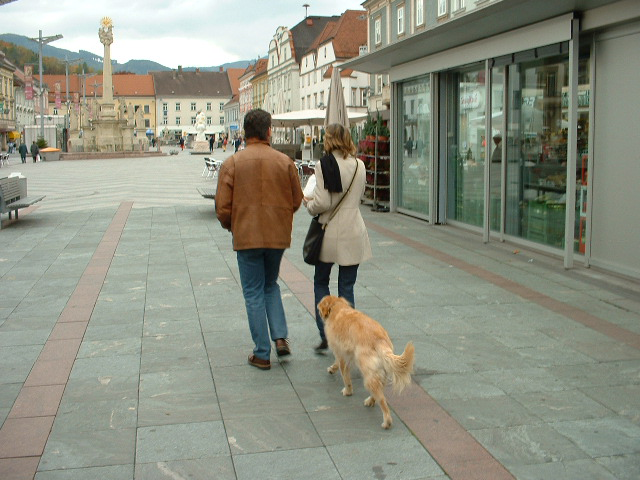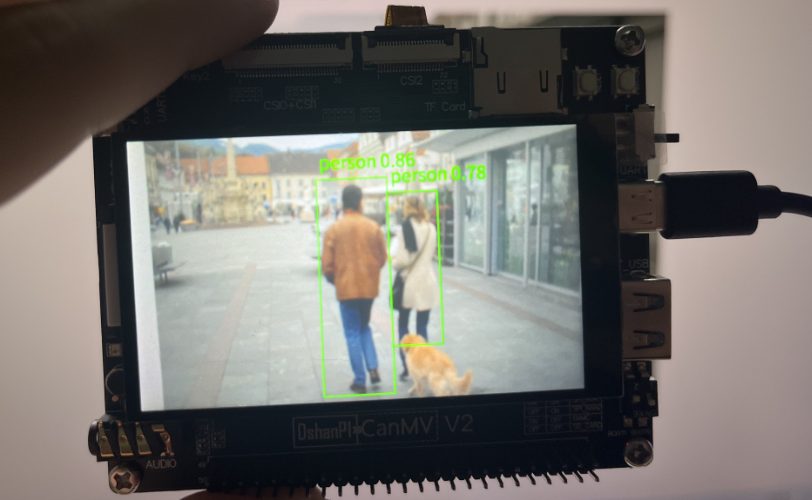人形检测
1.实验目的
基于YOLOv5n 模型,实现对人体的实时检测,图像获取、AI 预处理、推理、后处理和显示完整串联。
2.代码解析
核心类解析
PersonDetectionApp:自定义人体检测类
继承自 AIBase,封装了以下功能:
- 模型初始化、加载
- Ai2d 图像预处理配置(pad + resize)
- YOLO ��输出的后处理(调用
aicube.anchorbasedet_post_process) - 绘制检测框及标签到显示屏
person_det = PersonDetectionApp(
kmodel_path="/sdcard/examples/kmodel/person_detect_yolov5n.kmodel",
model_input_size=[640,640],
labels=["person"],
anchors=[...],
...
)
图像采集与显示
pl = PipeLine(rgb888p_size=[1920, 1080], display_size=[800, 480], display_mode="lcd")
封装了图像传感器的初始化、帧获取、OSD 图层绘制、图像显示等功能。
图像处理流程
1.预处理:config_preprocess()
通过 Ai2d 统一设置输入图像格式、类型和尺寸,常见操作包括:
- Pad:填充边缘,防止图像失真
- Resize:缩放到模型输入尺寸(如 640x640)
self.ai2d.pad([...])
self.ai2d.resize(...)
self.ai2d.build(...)
2.推理:run()(继承自 AIBase)
res = person_det.run(img)
会内部调用:
self.preprocess(img)self.interpreter.run(...)self.postprocess(results)
3.后处理:postprocess()
使用 aicube.anchorbasedet_post_process() 实现 anchor-based 检测结果转换,返回检测框信息 [cls_id, score, x1, y1, x2, y2]。
绘制结果
将检测框按比例缩放绘制到 OSD 层:
pl.osd_img.draw_rectangle(...)
pl.osd_img.draw_string_advanced(...)
排除了太小、靠边的干扰框,提升检测体验。
主循环
while True:
img = pl.get_frame()
res = person_det.run(img)
person_det.draw_result(pl, res)
pl.show_image()
gc.collect()
每帧执行完整流程:
- 获取帧
- 图像预处理 + 推理
- 后处理解析
- 绘制结果
- 显示到屏幕
3.示例代码
'''
本程序遵循GPL V3协议, 请遵循协议
实验平台: DshanPI CanMV
开发板文档站点 : https://eai.100ask.net/
百问网学习平台 : https://www.100ask.net
百问网官方B站 : https://space.bilibili.com/275908810
百问网官方淘宝 : https://100ask.taobao.com
'''
from libs.PipeLine import PipeLine, ScopedTiming # 导入图像处理管线类和计时器类
from libs.AIBase import AIBase # 导入AI推理基础类
from libs.AI2D import Ai2d # 导入图像预处理类
import os
import ujson
from media.media import * # 导入媒体库(图像采集、显示等)
from time import *
import nncase_runtime as nn # 导入NNCase推理引擎库
import ulab.numpy as np # 使用轻量化numpy库ulab,适配MCU
import time
import utime
import image
import random
import gc
import sys
import aicube # 导入aicube库(包含后处理函数)
# 自定义人体检测类,继承自AIBase
class PersonDetectionApp(AIBase):
def __init__(self,kmodel_path,model_input_size,labels,anchors,
confidence_threshold=0.2,nms_threshold=0.5,nms_option=False,
strides=[8,16,32],rgb888p_size=[224,224],display_size=[1920,1080],debug_mode=0):
super().__init__(kmodel_path,model_input_size,rgb888p_size,debug_mode)
self.kmodel_path = kmodel_path
self.model_input_size = model_input_size # 模型输入尺寸
self.labels = labels # 类别标签列表
self.anchors = anchors # 锚框配置
self.strides = strides # 各层输出特征图对应的stride
self.confidence_threshold = confidence_threshold # 置信度阈值
self.nms_threshold = nms_threshold # NMS抑制阈值
self.nms_option = nms_option # 是否开启NMS优化
# 设置图像采集尺寸(对齐到16)
self.rgb888p_size = [ALIGN_UP(rgb888p_size[0], 16), rgb888p_size[1]]
self.display_size = [ALIGN_UP(display_size[0], 16), display_size[1]]
self.debug_mode = debug_mode
# 创建Ai2D实例用于图像预处理(如pad、resize等)
self.ai2d = Ai2d(debug_mode)
self.ai2d.set_ai2d_dtype(nn.ai2d_format.NCHW_FMT, nn.ai2d_format.NCHW_FMT, np.uint8, np.uint8)
# 配置预处理流程,包括padding和resize
def config_preprocess(self, input_image_size=None):
with ScopedTiming("set preprocess config", self.debug_mode > 0):
# 使用默认输入图像尺寸或传入的自定义尺寸
ai2d_input_size = input_image_size if input_image_size else self.rgb888p_size
# 获取padding参数:top, bottom, left, right
top, bottom, left, right = self.get_padding_param()
self.ai2d.pad([0, 0, 0, 0, top, bottom, left, right], 0, [0, 0, 0])
self.ai2d.resize(nn.interp_method.tf_bilinear, nn.interp_mode.half_pixel)
# 构建预处理算子图
self.ai2d.build([1, 3, ai2d_input_size[1], ai2d_input_size[0]],
[1, 3, self.model_input_size[1], self.model_input_size[0]])
# 模型推理结果的后处理
def postprocess(self, results):
with ScopedTiming("postprocess", self.debug_mode > 0):
# 使用aicube提供的anchor-based检测后处理函数
dets = aicube.anchorbasedet_post_process(
results[0], results[1], results[2],
self.model_input_size, self.rgb888p_size,
self.strides, len(self.labels),
self.confidence_threshold, self.nms_threshold,
self.anchors, self.nms_option
)
return dets
# 绘制推理结果(绘制矩形框与类别文字)
def draw_result(self, pl, dets):
with ScopedTiming("display_draw", self.debug_mode > 0):
if dets:
pl.osd_img.clear()
for det_box in dets:
x1, y1, x2, y2 = det_box[2], det_box[3], det_box[4], det_box[5]
w = float(x2 - x1) * self.display_size[0] // self.rgb888p_size[0]
h = float(y2 - y1) * self.display_size[1] // self.rgb888p_size[1]
x1 = int(x1 * self.display_size[0] // self.rgb888p_size[0])
y1 = int(y1 * self.display_size[1] // self.rgb888p_size[1])
x2 = int(x2 * self.display_size[0] // self.rgb888p_size[0])
y2 = int(y2 * self.display_size[1] // self.rgb888p_size[1])
# 过滤掉边缘小目标或异常框
if (h < 0.1 * self.display_size[0]):
continue
if (w < 0.25 * self.display_size[0] and (x1 < 0.03 * self.display_size[0] or x2 > 0.97 * self.display_size[0])):
continue
if (w < 0.15 * self.display_size[0] and (x1 < 0.01 * self.display_size[0] or x2 > 0.99 * self.display_size[0])):
continue
# 绘制矩形框与检测标签
pl.osd_img.draw_rectangle(x1, y1, int(w), int(h), color=(255, 0, 255, 0), thickness=2)
pl.osd_img.draw_string_advanced(x1, y1 - 50, 32, " " + self.labels[det_box[0]] + " " + str(round(det_box[1], 2)), color=(255, 0, 255, 0))
else:
pl.osd_img.clear()
# 计算图像预处理时的padding填充值
def get_padding_param(self):
dst_w, dst_h = self.model_input_size
input_width, input_high = self.rgb888p_size
ratio_w = dst_w / input_width
ratio_h = dst_h / input_high
ratio = min(ratio_w, ratio_h)
new_w = int(ratio * input_width)
new_h = int(ratio * input_high)
dw = (dst_w - new_w) / 2
dh = (dst_h - new_h) / 2
top = int(round(dh - 0.1))
bottom = int(round(dh + 0.1))
left = int(round(dw - 0.1))
right = int(round(dw - 0.1))
return top, bottom, left, right
# 主程序入口
if __name__ == "__main__":
display_mode = "lcd" # 显示模式,可选"hdmi"或"lcd"
rgb888p_size = [1920, 1080] # 采集图像分辨率
# 根据显示模式设置显示分辨率
display_size = [1920, 1080] if display_mode == "hdmi" else [800, 480]
# 模型路径
kmodel_path = "/sdcard/examples/kmodel/person_detect_yolov5n.kmodel"
# 检测参数配置
confidence_threshold = 0.2
nms_threshold = 0.6
labels = ["person"]
anchors = [10, 13, 16, 30, 33, 23, 30, 61, 62, 45, 59, 119, 116, 90, 156, 198, 373, 326]
# 初始化图像处理管线
pl = PipeLine(rgb888p_size=rgb888p_size, display_size=display_size, display_mode=display_mode)
pl.create()
# 创建人体检测应用类实例并初始化
person_det = PersonDetectionApp(
kmodel_path,
model_input_size=[640, 640],
labels=labels,
anchors=anchors,
confidence_threshold=confidence_threshold,
nms_threshold=nms_threshold,
nms_option=False,
strides=[8, 16, 32],
rgb888p_size=rgb888p_size,
display_size=display_size,
debug_mode=0
)
person_det.config_preprocess()
try:
while True:
os.exitpoint() # 检查退出点
with ScopedTiming("total", 1):
img = pl.get_frame() # 采集当前图像帧
res = person_det.run(img) # 执行模型推理
person_det.draw_result(pl, res) # 绘制结果
pl.show_image() # 显示图像
gc.collect() # 回收内存
except Exception as e:
sys.print_exception(e) # 异常打印
finally:
person_det.deinit() # 模型反初始化
pl.destroy() # 销毁图像管线
4.实验结果

点击运行代码后,可以在显示屏上看到人形检测的结果。如下所示:
